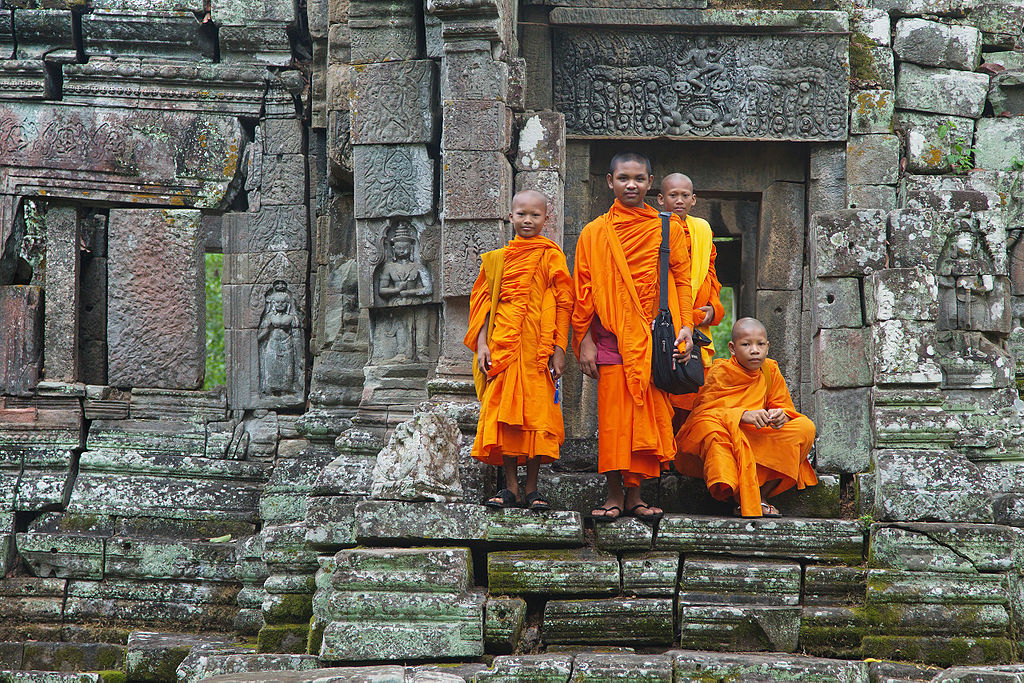Cambodia is a very photogenic country: spectacular temples that change personality with the shifting light of day, colonial architecture, river and lake vistas, forests and white sand beaches, and, most importantly, the country’s enigmatic and friendly people. Here are a few basic tips on how to get the best shots on your travels.

Preah Pithu T Monks in Siem Reap. Photo by JJ Harrison, (Own work) CC BY-SA 3.0, via Wikimedia Commons
As in all countries close to the equator, early morning, between sunrise and 9am, and in the afternoon 4pm-sunset, the so-called golden hours, are the best times to take pictures outside. Note that the light varies considerably from season to season. The Cambodian landscape generally looks best during and after the rainy season, June-December, before the plants wilt and dust covers everything. Some really dramatic light can be caught during the rains. The Angkor ruins look very otherworldly on storm-laden days in the summer.
For the most part, Cambodian people are happy to be photographed, although it is always polite to ask. Photography in temples is usually also not a problem, but it is advisable to ask before photographing monks. There are notable exceptions to this liberal attitude: Photography of police and the military as well as of military installations should be avoided. The Kompong Loeu, the indigenous people of Ratanakiri and Mondulkiri, don’t like to be photographed at all and may simply run away as soon as you pull your camera out. In some minority villages, the influx of tourists has led to demands for money. Photographers have to decide for themselves whether this is a good way to get a holiday snap.
The main enemy of camera gear in Cambodia, apart from heat and rain, is the dust. Especially in the northeast during the dry season, the fine red dust that swirls around anywhere there’s a road has a way of entering cameras and dirtying sensors, even if the lens is never separated from the body. Even fixed-lens cameras are not immune from this. Always make sure photography gear is well wrapped in plastic before setting off on a motorcycle trip.
Cameras and camera accessories are not particularly cheap in Cambodia, and visitors who intend to buy a camera during their trip around Asia would be better off doing so in Singapore, Malaysia, or Thailand. That said, i-Qlick (146 Sihanouk Blvd., tel. 023/996-638) is an authorized Canon shop in Phnom Penh that can undertake basic repairs of Canon models. Nikon also has a rep in Cambodia (HGB at #30, Russian Blvd., Sangkat Phsar Depo III, tel. 023/988-067).
Memory cards and film are available in Phnom Penh, Siem Reap, and, to a lesser degree, in Sihanoukville. Some smaller towns may have photo shops that sell cheap compact cameras, film, and occasionally some memory cards.
Having your pictures developed is not a problem in Phnom Penh, whether you use a digital or film camera. Be aware, though, that it’s unlikely a shop in Cambodia will handle your negatives with particular care. If you want to be certain no scratches appear on your film, have them developed when you get home.
Finally, always make sure your camera is securely stored when you take a walk in the busy streets of the capital. Fly-by robberies, typically two kids on a motorcycle zipping past and grabbing whatever you have over your shoulder, are not common, but they do occur more and more often. The risk increases if you take your camera out at night.
Excerpted from the Second Edition of Moon Angkor Wat.